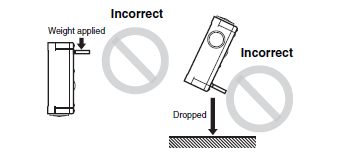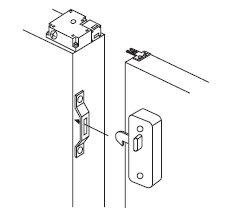 Cautions
Cautions
-
 Safety Components
Safety Components
-
 Safety Sensors
Safety Sensors
- Safety Door Switches
-
 Safety Limit Switches
Safety Limit Switches
-
 Safety Relays
Safety Relays
-
Safety Door Switches
|
|
| Precautions for Correct Use |
| Safety Precautions |
Precautions for Correct Use
Operation Key
Use only the designated Operation Key. The Head has been designed so that operation is not possible with a screwdriver or other tools. Using anything other than the designated Operation Key may damage the Switch or affect machine safety.
Do not operate the Switch with anything other than the special OMRON Operation Key, otherwise the Switch may break or the safety of the system may not be maintained.
Do not impose excessive force on the Operation Key while the Key is inserted into the Switch or drop the Switch with the Operation Key inserted. Doing either of these may deform the Key or break the Switch.

Securing the Door
If the closed door (with the Operation Key inserted) pulls the Operation Key past the operating/lock position (i.e., the set zone) because of, for example, the door's own weight, machine vibration, or the door cushion rubber, the Switch may be damaged.
Also, with a magnetic lock, it may not be possible to unlock the Switch if there is weight placed on the Operation Key. Secure the door with a stopper so that the Operation Key remains within the set zone.

Operating Environment
Safety Door Switches are designed for use indoors. Using a Switch outdoors may damage it.
Do not use the Switch in locations where toxic gases, such as H2S, SO2, NH3, HNO3, and Cl2, may be present, or in locations that are subject to high temperature or high humidity. Doing so may damage the Switch due to contact failure or corrosion.
Do not use the Switch in the following locations:
*Locations subject to severe temperature changes
*Locations subject to high temperatures or condensation
*Locations subject to severe vibration
*Locations where the interior of the Protective Door may come into direct contact with cutting chips, metal filings, oil, or chemicals
*Locations where the Switch may come into contact with thinner or detergents
*Locations where explosive or flammable gases are present
Storing Switches
Do not store Switches in locations where toxic gases, such as H2S, SO2, NH3, HNO3, and Cl2, may be present, or in locations that are subject to excessive dirt, excessive dust, high temperature, or high humidity.
Other Precautions
When attaching a cover, be sure that the seal rubber is in place and that there is no foreign material present. If the cover is attached with the seal rubber out of place or if foreign material is stuck to the rubber, a proper seal will not be obtained.
Perform maintenance inspections periodically.
Use the Switch with a load current that does not exceed the rated current.
Do not use any screws to connect the cover other than the specified ones. The seal characteristics may be reduced.


